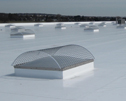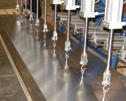The International Code Council (ICC) recently released the ICC 700-2008 National Green Building Standard™ (NGBS), the first American National Standards Institute (ANSI) standard addressing residential green building. ICC and the National Association of Home Builders (NAHB) developed the standard with input from their many stakeholders, including code officials and building professionals in the green construction field.
The standard
The NGBS promotes green, sustainable and high-performance construction methods; it includes guidelines for sustainable building practices applicable to the design and construction of residential buildings in the U.S.—from new and renovated single-family homes to high-rise residential buildings except institutional residences. Because a key component of a building's sustainability is owner buy-in, the NGBS also promotes homeowner education, including maintenance and proper operation.
Similar to other standards, the NGBS provides minimum requirements; however, unlike most standards, the NGBS awards points for meeting its requirements. In that sense, the standard is a rating system for residential construction's environmental performance. The NGBS contains four performance level categories—Bronze, Silver, Gold and Emerald.
Roofing specifics
The NGBS provides requirements in six categories: Lot Design, Preparation and Development; Resource Efficiency; Energy Efficiency; Water Efficiency; Indoor Environmental Quality; and Operation, Maintenance and Building Owner Education.
Insulation, vegetative roof systems, photovoltaic roof systems and cool roof surfaces can be used to achieve points related to land conservation and rainwater collection. Chapter 5—Lot Design, Preparation and Development awards points for installing a vegetative roof system for storm water management.
Vegetative roof systems and cool roof surfaces are included in Chapter 6—Resource Efficiency as methods to enhance durability and reduce maintenance. The chapter also lists ice barriers, flashings, recycling construction waste and using indigenous materials as requirements.
Chapter 7—Energy Efficiency includes practical ideas for ensuring an efficient insulation system. Skylight shafts require the same amount of insulation as exterior walls, and baffles or other similar measures are required at ventilated eaves to ensure proper air movement. Energy-efficient measures, such as radiant barriers and reflective surfaces, are options. Use of a continuous air space between a roof covering and roof deck provides for passive ventilation (referred to in the roofing industry as "above-sheathing ventilation").
Chapter 8—Water Efficiency addresses interior-related methods to reduce water consumption; no roofing-related items are included in this chapter.
Chapter 9—Indoor Environmental Quality includes requirements for using materials with low volatile organic compounds (VOCs), such as adhesives and sealants used in roof systems. You likely will be required to use low-VOC adhesives when installing certain membranes, flashings and sealants at counterflashings. These products may significantly affect low-temperature application of some materials. You should verify appropriate installation temperatures when working with low-VOC materials.
Chapter 10—Operation, Maintenance and Building Owner Education includes operations and maintenance manuals that can help a roof system reach its design service life. For roofing contractors, establishing homeowner maintenance programs can provide opportunities for agreements with homeowners.
Obtain a copy
With green building initiatives' continued advancement, you likely will begin to see specifications referencing NGBS. To obtain a copy of the standard and for more information, go to NAHB's Web site at www.nahbgreen.com.
James R. Kirby, AIA, is NRCA's associate executive director of technical communications.



